|
Cover
Story
Rediscovering
the Boats of Bangladesh
MUSTAFA
ZAMAN
 Baidyonath
Sutradhar is a builder by lineage. His name -- Sutradhar --
stands for it. It is, in fact, the Bangla of 'carpenter'.
Both his father and grandfather were boat builders. He hails
from a char Kalyanpur on the river Jamuna, in the district
of Pabna. For the builders, the end of monsoon usually meant
the season of boat building. The mahajans used to
come from far and wide to place their orders. The Kalyanpur
char, after remaining submerged during the rainy
season would transform into a bustling shipyard. Malar, Panshi,
Dingi were the boats that Baidyonath used to build. He specialises
in them and also makes all the other varieties, – Ghugi,
Balam, Ghashi, Padee and Horonga, to name a
few. Baidyonath
Sutradhar is a builder by lineage. His name -- Sutradhar --
stands for it. It is, in fact, the Bangla of 'carpenter'.
Both his father and grandfather were boat builders. He hails
from a char Kalyanpur on the river Jamuna, in the district
of Pabna. For the builders, the end of monsoon usually meant
the season of boat building. The mahajans used to
come from far and wide to place their orders. The Kalyanpur
char, after remaining submerged during the rainy
season would transform into a bustling shipyard. Malar, Panshi,
Dingi were the boats that Baidyonath used to build. He specialises
in them and also makes all the other varieties, – Ghugi,
Balam, Ghashi, Padee and Horonga, to name a
few.
A
mahajan once asked Baidynath to build a 70 hat (yard)
boat. He took it up as a challenge and started gathering Shal
and Garjan wood with this huge project in mind. It
took him 20 days to complete the boat and in the end, the
cost stood at eight lakh taka.
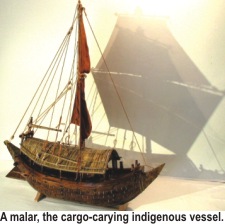 All
this seems like a fairytale now. The days of hectic schedule
and building amazing new pieces are behind him. In fact, the
whole culture of traditional boat-making took a blow when
the engine-run boats were introduced. The malar boat
that an enterprising couple Yves Marre and Runa Khan Marre
transformed into their first tourist vessel was built by Baidynath
himself. It was Haji Hazrat Ali, a mahajan, whose
relationship with the master builder Baidyanath goes back
a long way. The cargo-carrying malar of Ali that
used to ply in the Jamuna ended up being bought by the same
couple. In the words of Ali, one day in 1995, a shaheb
(foreigner) came and started photographing the boat he owned.
Later he accosted the owner with the offer of buying the boat.
His name was Yves, and he was from France. Ali had no reason
to sell his boat. However, Yves was a man bent on finding
one that he could buy. All
this seems like a fairytale now. The days of hectic schedule
and building amazing new pieces are behind him. In fact, the
whole culture of traditional boat-making took a blow when
the engine-run boats were introduced. The malar boat
that an enterprising couple Yves Marre and Runa Khan Marre
transformed into their first tourist vessel was built by Baidynath
himself. It was Haji Hazrat Ali, a mahajan, whose
relationship with the master builder Baidyanath goes back
a long way. The cargo-carrying malar of Ali that
used to ply in the Jamuna ended up being bought by the same
couple. In the words of Ali, one day in 1995, a shaheb
(foreigner) came and started photographing the boat he owned.
Later he accosted the owner with the offer of buying the boat.
His name was Yves, and he was from France. Ali had no reason
to sell his boat. However, Yves was a man bent on finding
one that he could buy.
 His
hunt for a malar had started from Narayanganj. He
was tipped off about a particular malar which had
already left for Munshiganj when Yves went to look for it.
He was relentless and followed its trail but ended up getting
lured by another malar in the river Dhaleshwari near
Munshiganj. Ali owned the boat. Yves, the explorer turned
humanitarian activist turned conservationist, then convinced
Ali to sell the boat to him. This was the first occasion that
would later lead to a string of activities culminating in
the show at the Bengal Shilpalaya, of small-scale boats of
Bangladesh. In the exhibition, master builder Baidyanath was
present with the other carpenters to demonstrate their craft.
The man who made it happen comes from France and is ready
to confer a 'gold medal' to Bangladeshis for their achievement
in boat building. His
hunt for a malar had started from Narayanganj. He
was tipped off about a particular malar which had
already left for Munshiganj when Yves went to look for it.
He was relentless and followed its trail but ended up getting
lured by another malar in the river Dhaleshwari near
Munshiganj. Ali owned the boat. Yves, the explorer turned
humanitarian activist turned conservationist, then convinced
Ali to sell the boat to him. This was the first occasion that
would later lead to a string of activities culminating in
the show at the Bengal Shilpalaya, of small-scale boats of
Bangladesh. In the exhibition, master builder Baidyanath was
present with the other carpenters to demonstrate their craft.
The man who made it happen comes from France and is ready
to confer a 'gold medal' to Bangladeshis for their achievement
in boat building.
Yves
Marre's maiden visit to Bangladesh was back in 1994. It was
a sojourn of two weeks. After that he came back one year later
"sailing the riverboat that had been transformed into
a Lifebuoy Friendship Floating Hospital". Yves's visit,
back then, had a different purpose. "I came to Bangladesh
with only one thing in mind, -- the 'floating hospital' project,"
clarifies Yves who has been living in Bangladesh since his
second visit.
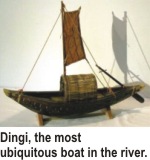 While
the Floating Hospital project is thriving, Yves got involved
with a different kind of work. Though not far removed from
his vision that sprang from a practical understanding of the
reality of Bangladesh, his new undertaking reveals a man empathetic
to the culture of a populace where he is just a stranger.
But this stranger has proved, to have tapped into a vast source
of Bangali history and pride. Yves and his wife Runa together
have reconstructed the history of boats of Bangladesh. This
reconstruction called for not only an understanding of the
speedy transformation of the marine landscape, where motored
boats were taking over, but also a commitment that has necessitated
a steady involvement over the last eight years. While
the Floating Hospital project is thriving, Yves got involved
with a different kind of work. Though not far removed from
his vision that sprang from a practical understanding of the
reality of Bangladesh, his new undertaking reveals a man empathetic
to the culture of a populace where he is just a stranger.
But this stranger has proved, to have tapped into a vast source
of Bangali history and pride. Yves and his wife Runa together
have reconstructed the history of boats of Bangladesh. This
reconstruction called for not only an understanding of the
speedy transformation of the marine landscape, where motored
boats were taking over, but also a commitment that has necessitated
a steady involvement over the last eight years.
Yves goes
back to the first few years of his endeavour, "The idea
of boats were not in my mind at that time." When he began
as a man bent on taking the clinic at the doors of the rural
poor, he was only a proponent of development, though his approach
was new and in conformity with the riverine country. The preservationist
in him emerged over the years, while he was at work out in
the rivers.
 Even
at the onset, during his first entry in Bangladesh, Yves cleaved
through the water as he took the route through the Sundarbans,
the mangrove crisscrossed with rivers and creeks. "My
first glance of Bangladesh was the river, it was the 14th
of May 1994," Marre recalls. His entry of port was Mongla,
Chittagong, but there was a cyclone in the Bay of Bengal and
it hit Chittagong three days before his arrival. This spurred
him to take the unusual route upon his arrival. Even
at the onset, during his first entry in Bangladesh, Yves cleaved
through the water as he took the route through the Sundarbans,
the mangrove crisscrossed with rivers and creeks. "My
first glance of Bangladesh was the river, it was the 14th
of May 1994," Marre recalls. His entry of port was Mongla,
Chittagong, but there was a cyclone in the Bay of Bengal and
it hit Chittagong three days before his arrival. This spurred
him to take the unusual route upon his arrival.
Yves
met Runa in Dhaka and she became not only his life partner
but also someone who shared his vision and work. "I met
Runa back in 1994, and when I came back we got married in
1996. I gave up my work in France as we decided to settle
down in Bangladesh. It made us think of a source of income,
and we thought of tourism using traditional boats," says
Yves. It isn't solely from this that the idea of replicating
the boats of Bangladesh took off. In Yves Marre's words, "It
came slowly to us, on its own, by itself...." They arranged
for the huge malar that was bought from Ali, the
mahajan, as a tourist boat to ply from Narayanganj
to the Sundarbans and even to the Bay of Bengal in winter
when the sea is calm. "We rebuilt two noukas
for tourism, -- a malar and a panshi. Not
that people are availing the boats, although we remodeled
them to bring them to a standard comfort and safety level.
But these two boats are like museum pieces now," clarifies
Runa.
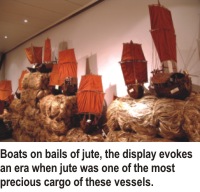 It
all started back in the days when the tourist boats were being
remade. "We were in Nagarbari, Pabna, in a building yard
where boats were still being built as it was about seven or
eight years ago. The bigger fleets of indigenous boats had
not yet disappeared. We were amazed by the beauty of various
boats then still plying," Yves recalls. "But after
a few years, we saw them trickle down at a formidable rate.
It is this that made us reach the conclusion that within two
or three years there will be none," he continues. "Even
in 1998 there was a kind of an equilibrium between the old
boats and the newer ones. We noticed that it was not the same
river, as sails were becoming a rare sight. From '98 onwards
it sharply declined," adds Runa. It
all started back in the days when the tourist boats were being
remade. "We were in Nagarbari, Pabna, in a building yard
where boats were still being built as it was about seven or
eight years ago. The bigger fleets of indigenous boats had
not yet disappeared. We were amazed by the beauty of various
boats then still plying," Yves recalls. "But after
a few years, we saw them trickle down at a formidable rate.
It is this that made us reach the conclusion that within two
or three years there will be none," he continues. "Even
in 1998 there was a kind of an equilibrium between the old
boats and the newer ones. We noticed that it was not the same
river, as sails were becoming a rare sight. From '98 onwards
it sharply declined," adds Runa.
In 1999
at the Nagarbari boat-building yard, there were only five
boats being repaired. "Whereas in 1988 there were 20
boats in the same yard," Runa reflects. "There were
not even five in the following year, hardly one or two in
2000, and now none," she maps the decline.
Marine
landscape of today belies the past glory of the vessels with
sails that used to swarm the rivers. That visual glory is
replaced by the modern-day alternatives built to step up velocity.
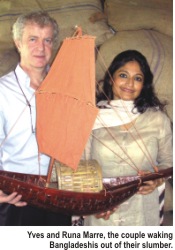 The
glory days of boat building is over. "Wooden boats are
being repaired rather than built. Big ones are being broken
into smaller units and are being used to build smaller ones,"
Runa discloses. The present riverscape confirms this. Other
than a few kosha or dingi, the small indigenous
boats, the rivers are full of steel-bodied boats. The wooden
ones too have incorporated motor engines. The
glory days of boat building is over. "Wooden boats are
being repaired rather than built. Big ones are being broken
into smaller units and are being used to build smaller ones,"
Runa discloses. The present riverscape confirms this. Other
than a few kosha or dingi, the small indigenous
boats, the rivers are full of steel-bodied boats. The wooden
ones too have incorporated motor engines.
This is
what progress does to tradition. "It happened in every
country, it happened in France long time ago. We are more
aware of the loss as we have seen it before. Therefore, after
being witness to the boats on the verge of extinction we thought
of preserving them, even as museum pieces," proclaims
Yves who has no complaint against modernisation of riverine
transportation as he thinks it is less polluting.
Yves strongly
feels that the past marine vessel specimens will have to be
preserved. His contention has a clear ground. "Bangladesh
has one of the oldest traditions in terms of naval carpentry,
and it also has the largest fleets in the world. It is in
Bangladesh that you will find the biggest number of different
types of boats," he says. The sailors of the boats in
Bangladesh had no awareness of this. The historical aspect
is something that may escape the notice of the masses, but
some people must pay attention. Yves and Runa did this in
their own unique way. "As far as people are concerned,
they are engaged in the battle of economic survival. Preservation
is the duty of the people who have the means to do so. It
is we who are responsible for maintaining the tradition,"
asserts Yves.
When
he took it as a mission to keep the tradition of boat building
alive, Yves did a little digging. "There are some texts,
most of them are stories about boats of Bangladesh,"
he says.
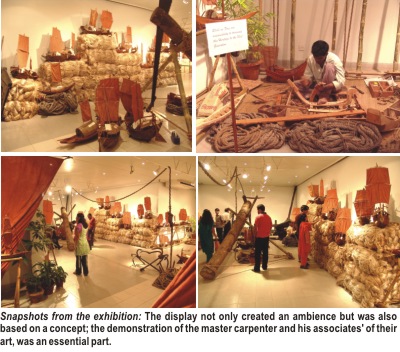 There
was no tradition of boat building in Bangladesh that used
pre-construction drawing. In fact the tradition was stilted
upon practical might, and the knowledge was handed down from
one generation to the next. "Before 1860 there were no
trace of drawings let alone designs of the construction. In
the National Marine Museum of France there are some drawings
of Bangladeshi boats by a Frenchman. There must be other drawings
in other places, it is also our mission to find out,"
Yves continues. There
was no tradition of boat building in Bangladesh that used
pre-construction drawing. In fact the tradition was stilted
upon practical might, and the knowledge was handed down from
one generation to the next. "Before 1860 there were no
trace of drawings let alone designs of the construction. In
the National Marine Museum of France there are some drawings
of Bangladeshi boats by a Frenchman. There must be other drawings
in other places, it is also our mission to find out,"
Yves continues.
Although
Bangladesh has a distinct marine tradition, it is also bound
with that of the world. What is very interesting is that there
are two different kinds of boats in Bangladesh. There are
river fleets and the sea-going fleets. "The sea-going
fleets had been influenced by the foreign fleets, the Chinese
and Arabian fleets left an impact, but the river boats were
built on indigenous knowledge alone," says Yves. It is
his observation that the fleets of Bangladesh have never been
mere copies of foreign ones. "They evolved on their own
integrating the influences of technological advancement,"
he says. About the riverine boats, he contends that they remained
the same. His deduction is based on the method of comparison.
"The
radar of the river-plying boats can be compared to that of
the Phoenicians'. I don't mean they were influenced by the
Phoenicians, rather they were built in the same era proving
that the tradition in Bangladesh go back three or four thousand
years," he adds.
 Riverboats
of Bangladesh have sails that cannot go against the wind.
"The technology of going against the wind was known by
the Arabs and the Latinos. Bangladeshis did not know this.
But the technology of using the steel-staples to put the planks
of the hull together is in use. It indicates that the marine
history of Bangladesh goes back at least three thousand years,"
Yves explains. Riverboats
of Bangladesh have sails that cannot go against the wind.
"The technology of going against the wind was known by
the Arabs and the Latinos. Bangladeshis did not know this.
But the technology of using the steel-staples to put the planks
of the hull together is in use. It indicates that the marine
history of Bangladesh goes back at least three thousand years,"
Yves explains.
To date
the technology, the Marre couple uses is a historical method
of comparison and they deduce that it was during the early
days of civilisation that the people in this delta had evolved
this expertise that has largely remained uninfluenced by foreign
knowledge. "There was hardly any influence from abroad
as far as the indigenous variety is concerned. This is why
you have so much variety," declares Yves who has religiously
pursued his passion -- the boat building project.
Professionally
Yves is a mixture of many expertises. He is not a doctor but
came up with the idea of running a floating hospital. Now
he and his wife are steering their own organisation which
aims to preserve the heritage of Bengal. It is not out of
whim that Yves began to dream of a museum solely dedicated
to the boats of Bangladesh. His love affair with the rivers
goes back a long time. "I even spent three months plying
through the creeks of the Amazon forests," he says. His
involvement always had a purpose, he did a stint as aviator
for the Flying Doctors. An adventurer at the core of his being,
Yves travelled across the globe "for more than 200 times"
by air and once by a barge across the Atlantic in 1993. That
same man settled down in Bangladesh and is now thinking of
raising money for the boat museum.
 His
ideas were anchored in the reverine reality of Bangladesh
from the start. "The floating hospital project is evolving
and more and more patients are being treated," he says.
The sole hospital that plies from Gaibandha and Chilmary will
be multiplied by next year. The second one will very soon
be launched and some small boats will also operate as clinics.
As his hospitals have been also tied up with the river, his
transformation from the purveyor of development ideas to a
preservationist seems natural. His
ideas were anchored in the reverine reality of Bangladesh
from the start. "The floating hospital project is evolving
and more and more patients are being treated," he says.
The sole hospital that plies from Gaibandha and Chilmary will
be multiplied by next year. The second one will very soon
be launched and some small boats will also operate as clinics.
As his hospitals have been also tied up with the river, his
transformation from the purveyor of development ideas to a
preservationist seems natural.
However,
the task was huge. "It was not very easy to go and find
boat carpenters; they usually have their building yards along
the banks of the three big rivers. At Nagarbari, on the bank
of the Jamuna, we spotted a master carpenter as we were looking
for the best builders who are still working," says Runa.
The couple started searching for them as early as in 1996.
And once they were in touch with one, it is through him that
they got hold of other carpenters from other areas. Then they
were stumbled upon the problem of making smaller models. "They
(the carpenters) had to be trained to make smaller models.
We had to make them understand that they could not use just
ordinary nails for the models, the 18 inch nails that are
usually used were reduced for the models," explains Runa.
The
exhibition that dazzled the Dhaka cognoscenti at the Bengal
Shilpalaya was not just an occasion to present mere replicas
of traditional Bangladeshi boats. They were not only made
to look like the originals but also made according to the
traditional methods. The carpenters were trained to replicate
the method they traditionally apply while building the originals.
"Even in boat museums across Europe you will not find
boats that replicate the process of making. Most of them are
mere models that look like the original," says Yves.
 Training
began in 2001 and a lot of pragmatic issues needed to be solved
during the building of the models. "They had to figure
out what type of wood could be used, as it would be difficult
to bend the planks when the scale is being drastically reduced,"
Runa relates. But the boats had to be made out of the usual
stock of wood. The Marres did not want to go for materials
that were easier to handle but were never used in building
boats. All this took a lot of time. But in the end the results
were astonishing. Training
began in 2001 and a lot of pragmatic issues needed to be solved
during the building of the models. "They had to figure
out what type of wood could be used, as it would be difficult
to bend the planks when the scale is being drastically reduced,"
Runa relates. But the boats had to be made out of the usual
stock of wood. The Marres did not want to go for materials
that were easier to handle but were never used in building
boats. All this took a lot of time. But in the end the results
were astonishing.
Sitting
among the models in his office, Yves reflects on his endeavour,
"It is a new concept in curating, the technologies and
the traditions were replicated in these boats." "With
the marine museums in Europe, the model makers are never the
ones who are the traditional boat makers. Usually the boats
are reproduced from drawings or sketches or pictures. They
look nice but unlike ours the process was never replicated,"
He adds. Even the sails, which many thought failed to match
the variety found in reality, are made of the same cheapest
cotton that has been in use for hundreds of years. The colour
of the sails too had been in conformity with the tradition.
"They were even dyed with the same colour, which is earth.
This is the colour that a new sail traditionally used to have.
The white sails and patches are the inevitable changes that
take place over time," Runa clarifies.
 Yves
took one of the models to Paris and showed it to the model
makers of the marine museum in Paris. They as well the curator
took so much interest in it that "they came to have a
look as it was a new concept." For Dhaka's viewers it
was a time of reclamation; never in their wildest dreams could
they realise that boats could be a source of pride. The show
at the Bengal Shilpalaya has rediscovered a whole new frontier
that no one knew existed. The variety and the richness of
the tradition have never been considered before. It is ironic
that a European had to unearth this treasure trove of a nation
known for its inordinate attachment to traditional beliefs. Yves
took one of the models to Paris and showed it to the model
makers of the marine museum in Paris. They as well the curator
took so much interest in it that "they came to have a
look as it was a new concept." For Dhaka's viewers it
was a time of reclamation; never in their wildest dreams could
they realise that boats could be a source of pride. The show
at the Bengal Shilpalaya has rediscovered a whole new frontier
that no one knew existed. The variety and the richness of
the tradition have never been considered before. It is ironic
that a European had to unearth this treasure trove of a nation
known for its inordinate attachment to traditional beliefs.
Twenty-five
small-scale boats were built and 23 were put on display at
the gallery. In Bangladesh, the names of the boats may confuse
many, as one boat has many names. "It changes according
to the regions, as does the rivers," Runa chips in. "The
sea-going boats have foreign names. As for the river-going
ones the names are always Bangladeshi. The Bangla name dingi
is now being used around the world. The British took the name
dingi, it is also the same in France," informs
Yves.
The
week-long exhibition that kicked off on October 5 at the Bengal
gallery was an exotic sight. The miniature boats were displayed
on bails of jute, sacks, wooden boxes and even coiled ropes.
Even the remnants of a boat at the front room was displayed
as if a wayfarer on a char was discovering it. The
show also included a master builder working on his model boat
at the end of the second room of the gallery. "The anchors
and ropes are from our own boats, the sails used for the backdrop
are also from actual boats, and the sacks and bails are a
reminder of the cargo the boats usually carry," explains
Yves. "We wanted the people to get a feeling of the past,
the history of the boats and what these boats were really
about," he says. The comment from an art connoisseur
sums up their effort, "This was not an exhibition but
a museum."
 The
exhibition made an effort to generate awareness on how this
tradition could be preserved. To elucidate the concept of
decay they presented a fossil-like boat in one end. However,
at the other end there was this master carpenter and his apprentices
at work, alluding to the effort that can go to revive the
tradition even in different forms. The
exhibition made an effort to generate awareness on how this
tradition could be preserved. To elucidate the concept of
decay they presented a fossil-like boat in one end. However,
at the other end there was this master carpenter and his apprentices
at work, alluding to the effort that can go to revive the
tradition even in different forms.
Yves has
plans for the museum to have an ancillary wing to promote
tourism through traditional boats. "A tourist would love
to sail on a boat which has a history of several thousand
years, which literally is a museum piece" he claims.
This is the kind of tourism that the Marre couple has initiated.
To be able manage the financial aspect of this project was
a tough hurdle. A friend of the Marres, who lives in the US,
had initially provided them with the funds to launch their
boat-building project. During the last eight years, a lot
of their own money was poured in to continue the model-building
efforts. Now, at this point, after the show, which was fully
sponsored by the Bengal Shilpalya, they cannot sustain the
project on their own. "We have made some efforts to raise
awareness in the local as well as in the international communities
to lend us a hand. And we have already received some responses
in terms of interest," says Yves. Several countries have
shown interest in the project, but how they will help them
contact the museums and organisations that would finally be
their sponsors are yet to be mapped. Yves is hopeful, "The
main thing is that the project took off, and we hope that
it will create a snowball effect."
The main
reward for the couple has been the realisation that they have
helped uncover a treasure, which people have recognised. "It
gives me pleasure to think that we could make them feel proud
of their own ingeniousness in boat building. The exhibition
also made people of all walks of life aware that it is something
worth saving and that this is the time to act," Yves
exclaims.
Many
ambassadors and local influential personalities have come
to savour the beauty of these boats and to respond to the
crying need of their preservation. The Marre couple's dream
project has now reached what they themselves term as a 'synergy'
from where the journey to make the living boat museum a reality
begins.
Copyright
(R) thedailystar.net 2004
|
